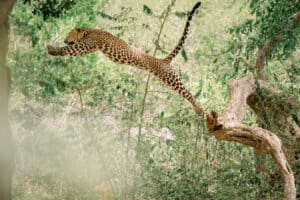Many billions of years ago, the dinosaurs went extinct. This period is when the first primates appeared. Primates then changed over millions of years into the monkeys and apes we know today. This article explores primates from prehistoric times you should know about, including lemurs and hominids.
1. Afropithecus — The Prehistoric African Ape

Afropithecus lived around 17 million years ago.
©Ghedoghedo / CC BY-SA 3.0, , via Wikimedia Commons – Original / License
Afropithecus lived in the jungles of what we know today as Africa. Its name came from Greek, meaning “African Ape.” Afropithecus lived around 17 million years ago. Experts estimate that Afropithecus stood about five feet tall and weighed approximately 100 pounds. It was large and had a long snout with large teeth. Specialists believe this African ape ate fruits and seeds primarily and was chiefly a tree-dwelling creature. Like most other great apes, it most likely walked on all fours instead of two legs. Researchers Richard and Mary Leaky unearthed fossils in 1986 near Lake Turkana in Northern Kenya, describing it as a separate species.
2. Archicebus
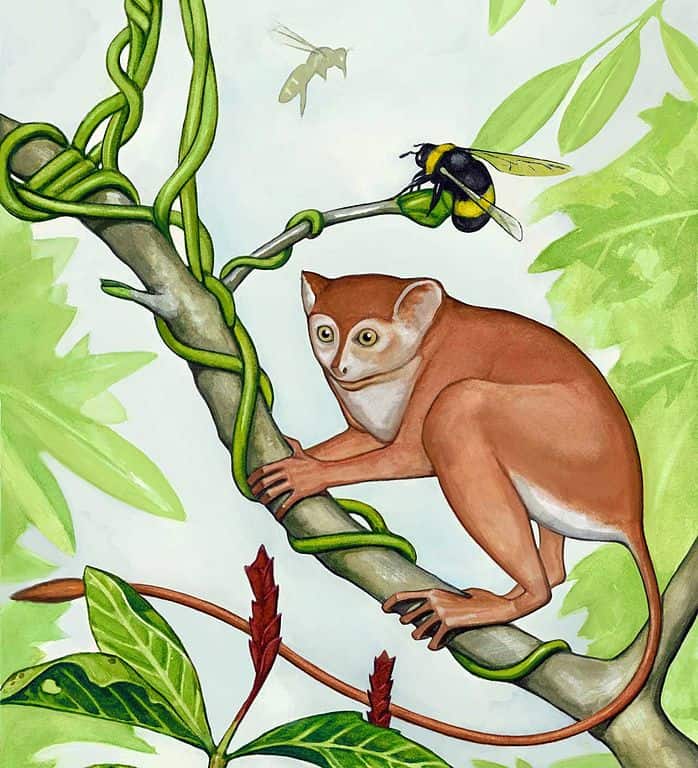
Archicebus existed around 55 million years ago and likely only weighed 0.7-1 ounces.
©Mat Severson / CC BY-SA 4.0, , via Wikimedia Commons – Original / License
Archicebus means “long-tailed monkey” in Greek. This fossil is among the oldest on record, proving this monkey walked the earth approximately 55 million years ago. Some paleontologists believe that the Archicebus belonged to a tarsier group of primates. It was a small tree-dwelling monkey, about the size of a pygmy mouse lemur. However, it probably only weighed about 0.7-1 ounces.
Nearly complete Archicebus fossils were buried in shale in an ancient lake bed in China in 2002. Scientists from the Institute of Vertebrate Palaeontology and Palaeoanthropology in Beijing made this discovery. These fossils were the first nearly complete skeletons that paleontologists found in the area. They were proof that Archicebus had lived in the Asian woodlands. Their features indicated that it had grasping feet and a long prehensile tail. Moreover, paleontologists believe this monkey fed primarily on insects, and its small eye sockets suggest it was most active during the day.
3. Babakotia

It believed Babakotia was an excellent climber and lived very high in the tree canopy.
The name Babakotia comes from the Malagasy word for the Indri, Babakoto. Babakotia inhabited the woodlands of Madagascar around two million to 2,000 years ago. Researchers determined that this animal weighed between 30 and 40 pounds and was approximately four feet long. Babakotia and some others are also known as sloth lemurs. Fossils show that this prehistoric monkey had long forearms and large skulls. These physical traits mean that it looked more like sloths than lemurs. Researchers also speculate that the Babakotia behaved more like sloths than lemurs.
Additionally, paleontologists believe the Babakotia was an excellent climber and lived very high in the tree canopy. This behavior made it difficult for predators to catch it. Its diet most probably consisted of leaves, fruits, and seeds. Experts determine that the Babakotia died out due to hunting and habitat loss. This extinction probably occurred shortly after humans arrived in the region known as Madagascar today, approximately 2,000 years ago.
4. Dryopithecus
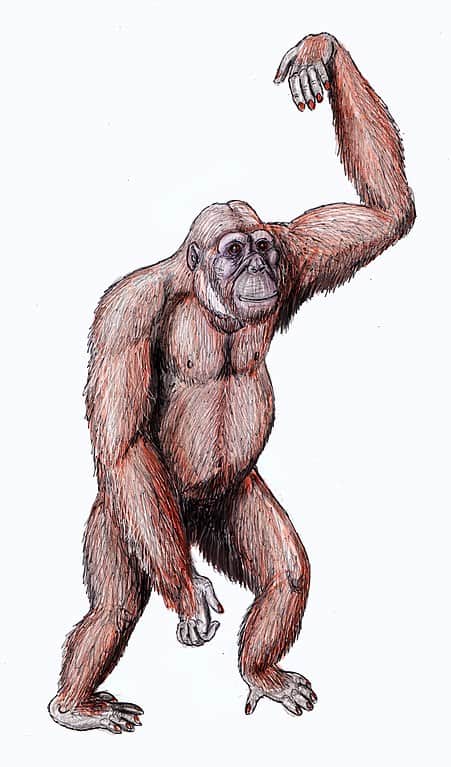
Unusually, fossils of Dryopithecus have been found in Europe and Aisa.
©DiBgd / CC BY-SA 4.0, , via Wikimedia Commons – Original / License
Dryopithecus was a mid-sized ape originally from Africa. The name Dryopithecus comes from Greek and means “Tree Ape.” Primatologists reckon that the Dryopithecus inhabited mainly woodlands and later migrated to Europe and Asia. Fossils show that the Dryopithecus was only about four feet long, making it a mid-sized ape. Experts estimate its weight at around 25 pounds. Dryopithecus had long arms and a chimpanzee-shaped head.
Apparently, this prehistoric ape went extinct about 10 million years ago. Dryopithecus is unusual because experts have also found fossils in Europe and Asia. The fossils found in Europe are fascinating because of the distinct absence of indigenous monkeys on the continent. But, those who study primates believe that Dryopithecus mostly lived in the tree tops and ate fruits. However, how its body is built shows that Dryopithecus could walk on its knuckles like most apes. In addition, it could run on its hind legs, especially when chased by predators.
5. Eosimias
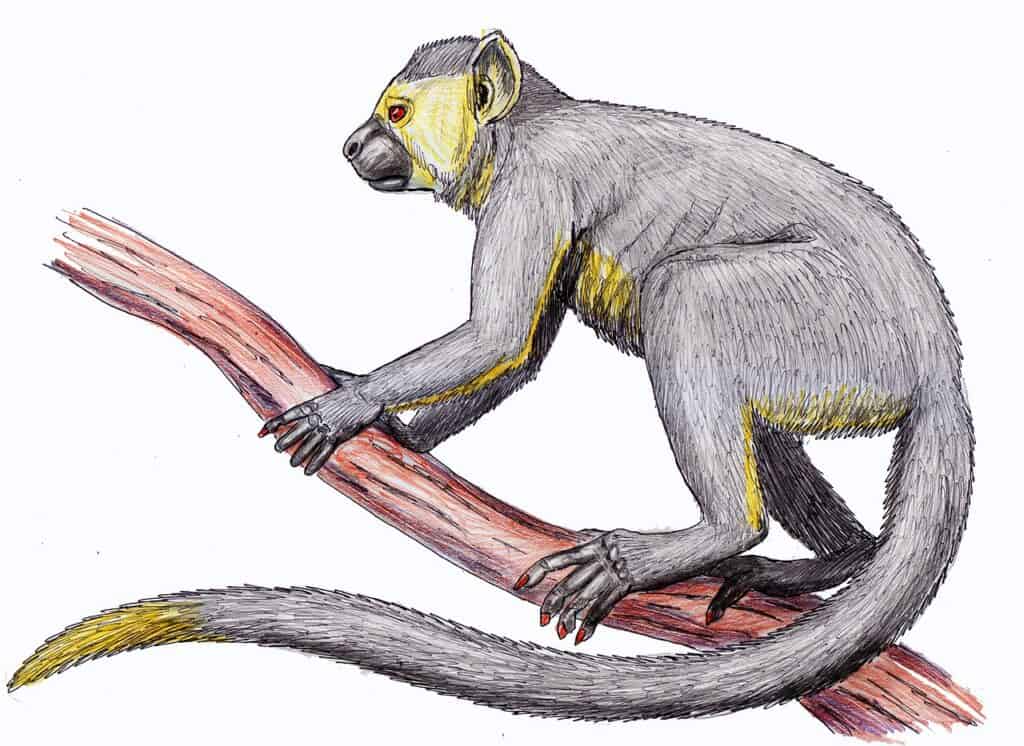
Experts believe the Eosimias was tree-dwelling in order to evade ground-dwelling mammals.
Eosimias is Greek and means “Dawn Monkey.” This tiny monkey lived in the woodlands of Asia. It was only a few inches long and weighed approximately one ounce. Scientists found fossils of Eosimias mainly in Asia, consisting of jaws, teeth, and foot bones. These researchers believe this prehistoric monkey died out about 40 million years ago.
Additionally, experts believe this little monkey was tree-dwelling and nocturnal. And it probably developed these traits to escape larger ground-dwelling mammals. Unfortunately, not much is known about its diet, as only incomplete parts of fossils have been found.
6. Gigantopithecus – One of the Biggest Prehistoric Monkeys

Gigantopithecus was huge, and stood about nine feet tall and weighed 1,000 pounds.
©Concavenator / CC BY-SA 4.0, , via Wikimedia Commons – Original / License
The word Gigantopithecus is of Greek origin and means “Giant Ape.” The Gigantopithecus was found in the woodlands of Asia and lived about six million to 200,000 years ago. As its name suggests, the Gigantopithecus was huge. This ape stood about nine feet tall and weighed 1,000 pounds. At least, this is what experts deduce from fossil findings. In the early 20th century, Chinese apothecaries sold pieces of jaws and teeth to the public. This commercial behavior was the first indication that people had discovered a Gigantopithecus fossil. However, the scattered and fractured fossil pieces made it challenging for paleontologists to reconstruct the Gigantopithecus skeletons. Still, researchers believed that this prehistoric monkey was herbivorous and could walk on its hind legs.
7. Megaladapis
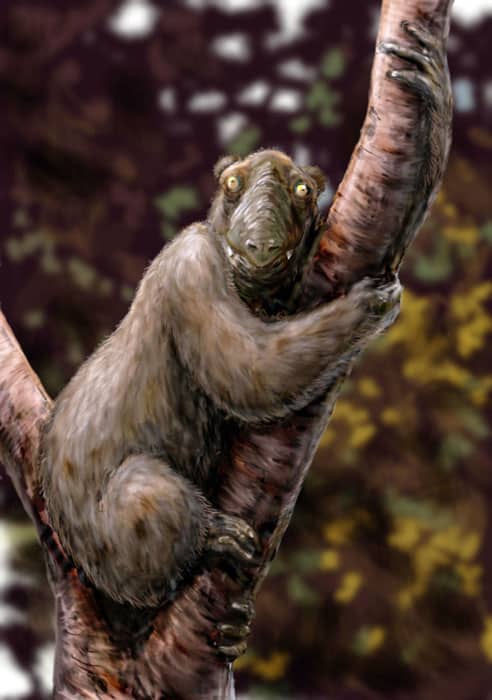
Overhunting is one possible reason for the Megaladapis’ extinction.
©FunkMonk (Michael B. H.) / CC BY-SA 3.0, , via Wikimedia Commons – Original / License
The word Megaladapis is Greek and means “giant lemur.” Paleontologists discovered this giant lemur in the Madagascan forests. It is estimated to have been five feet long and weighed about 100 pounds. This giant was around from approximately two million to 10,000 years ago. Hunting in excess is one possible reason for its extinction. In addition, early humans used a technique of brush-clearing called “slash and burn,” which led to habitat loss and eventual demise. The Megaladapis had a large head and short limbs, unlike its more modern cousins. In addition, Megaladapis fossils show that it had cow-like teeth. This characteristic would have benefited the Megaladapis, as paleontologists believe it ate hardy leaves. And, as it was mostly a tree-dwelling prehistoric primate, its hands and feet were adapted to grab onto branches. This attribute would have prevented the Megaladapis from traveling long distances on the ground.
Summary of 7 Prehistoric Primates You Should Know About
Here’s a recap of the seven prehistoric primates that we took a close look at.
| Number | Primate | Time of Existence | Habitat | Estimated Size |
|---|---|---|---|---|
| 1 | Afropithecus | Around 17 million years ago | African jungles | 5 feet tall; weighed about 100 pounds |
| 2 | Archicebus | About 55 million years ago | Asian woodlands | Weighed about 0.7-1 ounces |
| 3 | Babakotia | Approximately 2 million to 2,000 years ago | Woodlands of Madagascar | 4 feet long; weighed 30-40 pounds |
| 4 | Dryopithecus | Became extinct about 10 million years ago | Mainly woodlands in Africa; later migrated to Europe and Asia | 4 feet long; weighed around 25 pounds |
| 5 | Eosimias | Died out about 40 million years ago | Woodlands of Asia | A few inches long; weighed about 1 ounce |
| 6 | Gigantopithecus | About 6 million to 200,000 years ago | Asian woodlands | About 9 feet tall; weighed 1,000 pounds |
| 7 | Megaladapis | 2 million to 10,000 years ago | Madagascan forests | 5 feet long; weighed about 100 pounds |
The photo featured at the top of this post is © Concavenator / CC BY-SA 4.0, , via Wikimedia Commons – License / Original
Thank you for reading! Have some feedback for us? Contact the AZ Animals editorial team.





